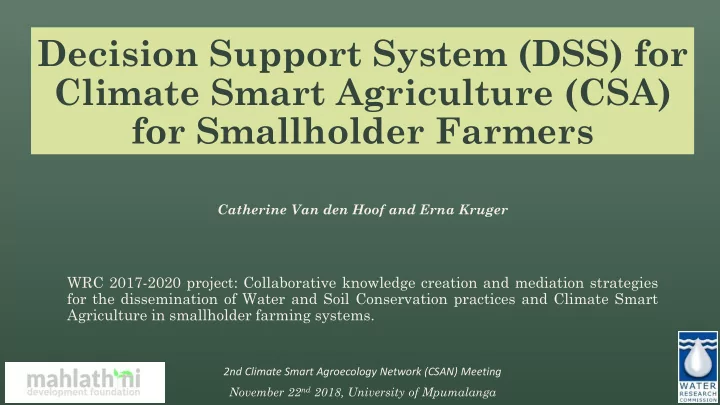

Decision Support System (DSS) for Climate Smart Agriculture (CSA) for Smallholder Farmers Catherine Van den Hoof and Erna Kruger WRC 2017-2020 project: Collaborative knowledge creation and mediation strategies for the dissemination of Water and Soil Conservation practices and Climate Smart Agriculture in smallholder farming systems. 2nd Climate Smart Agroecology Network (CSAN) Meeting November 22 nd 2018, University of Mpumalanga
Change in Farm Productivity
What is Climate Smart Agriculture (CSA)? • Minimize external inputs • Maximise internal diversity • Focus on soil health and natural soil building techniques • Take care of the environment • Use available water as efficiently as possible. • Work together, learn together and plan together • Local solutions and economies • Farmer driven development • Getting our hands dirty
What is a Decision Support System (DSS)? DSS are designed to help users make more effective decisions by leading them through clear decision stages and presenting the likelihood of various outcomes resulting from different options. These can be software tools, whose recommendations vary according to user's inputs, and they may suggest optimal decision path.
What is a Decision Support System (DSS)? The objective of our DSS is to assist individual farmers or farming collectives in selecting appropriate options of managements practices to sustain and increase farm productivity given current climate, soil, topography, farming system and socio-economic conditions, and to strength their farming practices in light of climate change. The DSS considers individual circumstances, needs and aspirations.
DSS for CSA - Best Management Practices FARMING SYSTEM PHYSICAL ENVIRONMENT FARMER SOCIO-ECONOMIC BACKGROUND RESOURCES TO MANAGE DSS PROCESS FLOW SUGGESTED PRACTICES CONSTRAINED BY TYPOLOGY, SYSTEM ENVIRONMENT FACILITATOR FARMER BASED BASED PRIORITIES PRIORITIES RANKED PRACTICES RANKED PRACTICES BASED ON FACILITATOR BASED ON FARMER
How Does the DSS Work in Practice?
Example for 3 Smallholder Farmers
Input for DSS: e.g. Farmer in Sekororo FARMING SYSTEM PHYSICAL ENVIRONMENT FARMER SOCIO-ECONOMIC BACKGROUND RESOURCES TO MANAGE SUGGESTED PRACTICES CONSTRAINED BY TYPOLOGY, SYSTEM ENVIRONMENT FACILITATOR FARMER BASED BASED PRIORITIES PRIORITIES RANKED PRACTICES RANKED PRACTICES BASED ON FACILITATOR BASED ON FARMER
Output of DSS: Suggested Practices FARMING SYSTEM PHYSICAL ENVIRONMENT FARMER SOCIO-ECONOMIC BACKGROUND RESOURCES TO MANAGE SUGGESTED PRACTICES Resources and management strategies Water soil crop/tree resistance Livestock resistance CONSTRAINED BY (quantity) (fertility) and efficiency and efficiency TYPOLOGY, SYSTEM improvement use efficiency conservation Harvesting ENVIRONMENT retention nutrient nutrient disease disease Water Water Heat Heat FACILITATOR FARMER BASED BASED PRIORITIES PRIORITIES RANKED PRACTICES RANKED PRACTICES BASED ON FACILITATOR BASED ON FARMER
Prioritization by Farmer & Facilitator For each suggested practice, scores (1-3) are provided per theme by FARMING SYSTEM PHYSICAL ENVIRONMENT FARMER SOCIO-ECONOMIC BACKGROUND facilitator concerning impact on: water • RESOURCES TO MANAGE soil • crop • Livestock • SUGGESTED PRACTICES Tree and natural resources • CONSTRAINED BY TYPOLOGY, SYSTEM farmer concerning need for/benefit ENVIRONMENT to: labour • investment • skills • FACILITATOR FARMER BASED crop productivity • BASED PRIORITIES PRIORITIES water saving • RANKED PRACTICES RANKED PRACTICES This helps to identify the practices that have BASED ON FACILITATOR BASED ON FARMER a higher probability of being adopted or not
Divergence in Suggested Practices ??? Clay soils, sub-humid cool AEZ.. Focus on soil improvement however with less options in Mxumbu due to aridity, and less options still in Sekororo due to typology of farmer (A) and restricted farming practices.
What Now? FARMING SYSTEM PHYSICAL ENVIRONMENT FARMER SOCIO-ECONOMIC BACKGROUND RESOURCES TO MANAGE DSS PROCESS FLOW SUGGESTED PRACTICES CONSTRAINED BY TYPOLOGY, SYSTEM ENVIRONMENT FACILITATOR FARMER BASED BASED PRIORITIES PRIORITIES RANKED PRACTICES RANKED PRACTICES BASED ON FARMER BASED ON FACILITATOR
… and in the Future? FARMING SYSTEM PHYSICAL ENVIRONMENT FARMER SOCIO-ECONOMIC BACKGROUND RESOURCES TO MANAGE SUGGESTED PRACTICES CONSTRAINED BY TYPOLOGY, SYSTEM ENVIRONMENT FACILITATOR BASED FARMER BASED PRIORITIES PRIORITIES RANKED PRACTICES RANKED PRACTICES BASED ON FACILITATOR BASED ON FARMER
Thank you!!
Recommend
More recommend